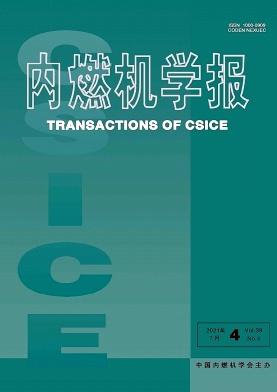THERMOPHYSICAL CHARACTERISTICS OF THE HVAF COATING FROM QUASICRYSTALLINE ALLOY OF THE Al-Cu-Fe SYSTEM
Q4 Engineering
引用次数: 0
Abstract
The article deals with the results of determining the thermal conductivity coefficient from quasicrystalline coatings of the Al-Cu-Fe system in the temperature range up to 900 °C. The Al-Cu-Fe quasicrystalline alloy acquires a great interest for practical use as a material for protective coatings. The Al-Cu-Fe alloy is used to produce thermal barrier coatings in internal combustion engines, non-stick coatings on chemical synthesis equipment and in the food industry and to prevent the icing in aviation. The Al-Cu-Fe quasicrystals have low density, high hardness, high elasticity modulus, high values of corrosion resistance and wear resistance, low coefficient of friction, lowered adhesion, low thermal conductivity in combination with the coefficient of thermal expansion, which is close by its value to some metals. The water atomized Al63Cu25Fe12 powder with a dispersion of +40/-63 μm that has a content of the quasicrystalline phase of about 60 wt. % was used for spraying. The coating was sprayed to the butt of a cylindrical substrate from steel 45 (diameter – 25 mm, height – 10 mm), which before spraying was subjected to jet-abrasive treatment by corundum powder with a determining particle size of 1 mm at air pressure of spraying of 0.5 MPa. The Al-Cu-Fe coating with a thickness of more than 0.8 mm was made by high-speed air-fuel (HVAF) spraying using a burner GVO-RV12 with the following spraying mode: the pressure in the combustion chamber of the burner is 1.0 MPa; the oxidant excess coefficient a ≈ 1.2, the spraying distance is 270 mm. The samples were installed on the side surface of the drum (diameter 120 mm), which rotates at a speed of 2.0 rev/s (the speed of movement of the sputtering spot is 0.8 m/s). Spraying was done in three steps of 10 seconds each with a 30 second cooling time between them. Determination of the temperature dependence of the thermal conductivity of the coating was carried out by solving the inverse problem of thermal conductivity by one-dimensional temperature fields in samples obtained by single-sided jet heating with an industrial hot air torch (at surface temperatures up to 450 °C) and an oxygen-propane welding torch (at temperatures above 450 °C). It is shown that the values of the thermal conductivity coefficient of Al-Cu-Fe quasicrystalline coatings in the range of 20 °С…900 °С vary within λ = 1.9 – 2.31 W/(m×K).Al-Cu-Fe系准晶合金HVAF涂层的热物理特性
本文讨论了Al-Cu-Fe系准晶涂层在900℃温度范围内导热系数的测定结果。Al-Cu-Fe准晶合金作为一种防护涂层材料在实际应用中引起了极大的兴趣。Al-Cu-Fe合金用于制造内燃机的热障涂层,化学合成设备的不粘涂层和食品工业,以及航空中的防结冰。Al-Cu-Fe准晶具有低密度、高硬度、高弹性模量、高耐蚀性和耐磨性、低摩擦系数、低附着力、低导热系数和热膨胀系数,与某些金属接近。采用分散度为+40/-63 μm、准晶含量约为60 wt. %的水雾化Al63Cu25Fe12粉末进行喷涂。将45钢(直径- 25mm,高度- 10mm)喷涂到圆柱形基体的对接处,在喷涂前用确定粒径为1mm的刚玉粉在0.5 MPa的喷涂气压下进行喷磨处理。采用GVO-RV12型燃烧器,采用高速空气燃料(HVAF)喷涂,喷涂方式为:燃烧器燃烧室压力1.0 MPa;氧化剂过量系数a≈1.2,喷涂距离为270 mm。样品被安装在直径为120 mm的圆筒的侧面上,以2.0转/秒的速度旋转(溅射点的运动速度为0.8米/秒)。喷雾分三步进行,每步10秒,间隔30秒冷却时间。利用工业热风焊炬(表面温度高达450℃)和氧丙烷焊炬(温度高于450℃)单面喷射加热获得的样品,通过求解一维温度场的导热系数逆问题,确定了涂层导热系数的温度依赖性。结果表明,Al-Cu-Fe准晶涂层在20°С ~ 900°С范围内的导热系数在λ = 1.9 ~ 2.31 W/(m×K)范围内变化。
本文章由计算机程序翻译,如有差异,请以英文原文为准。
求助全文
约1分钟内获得全文
求助全文

 求助内容:
求助内容: 应助结果提醒方式:
应助结果提醒方式:


